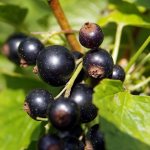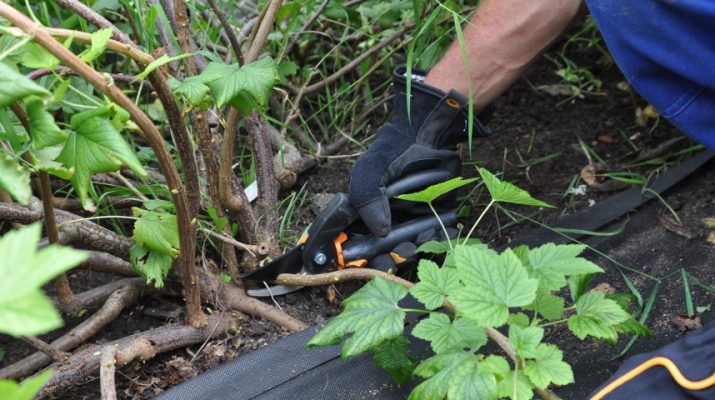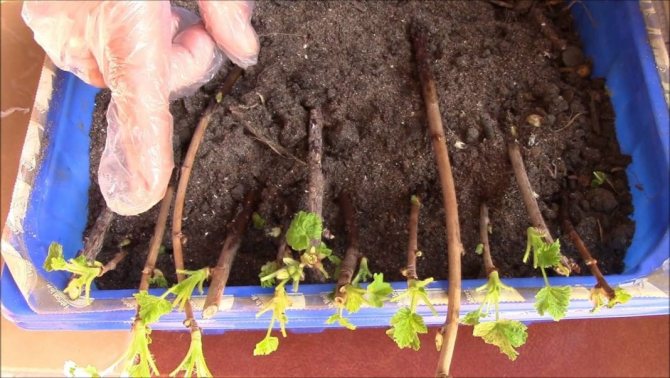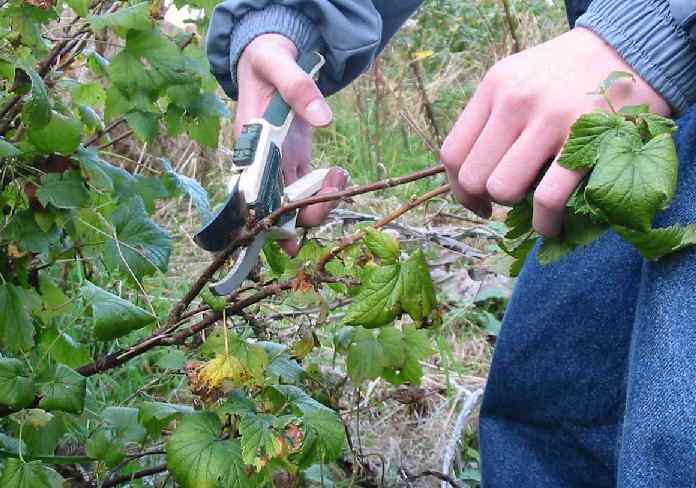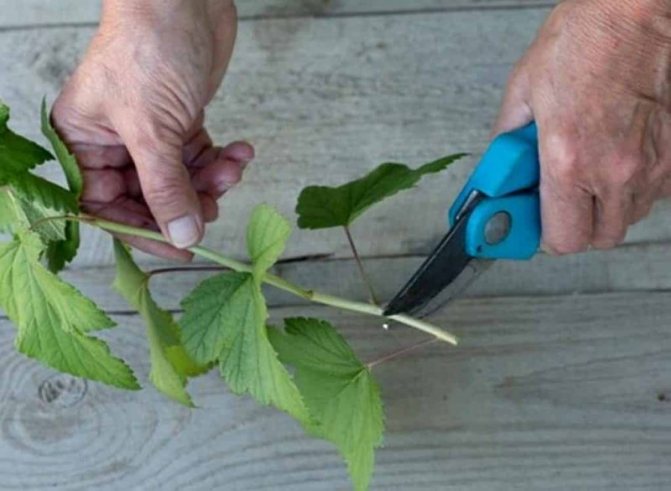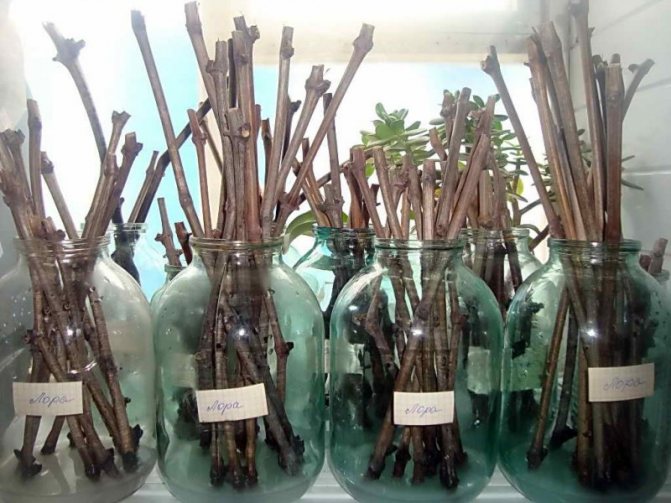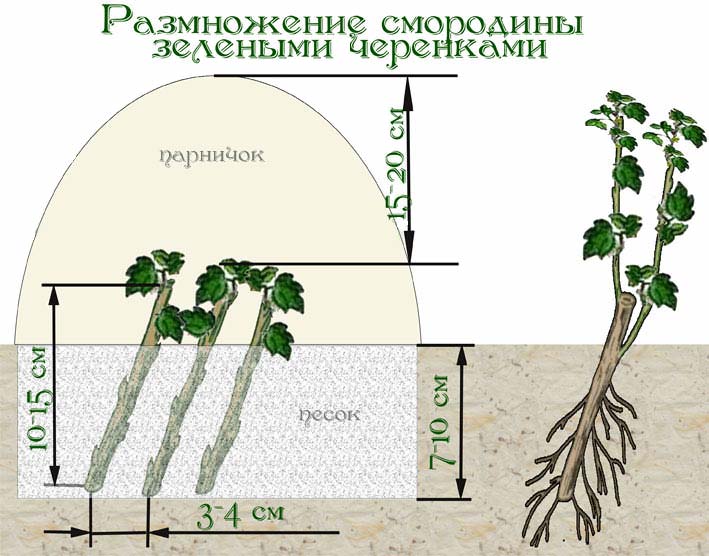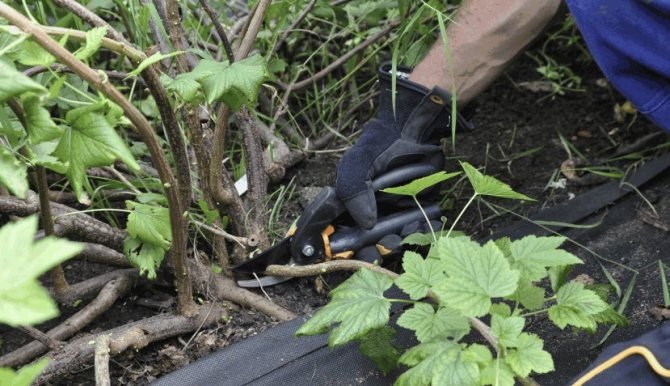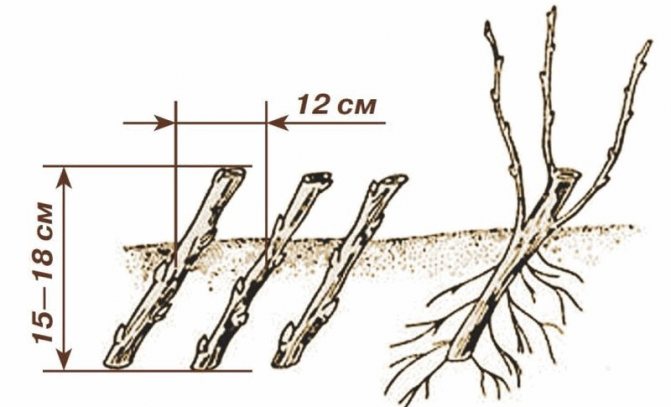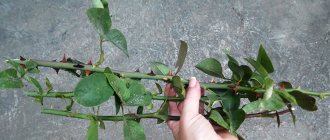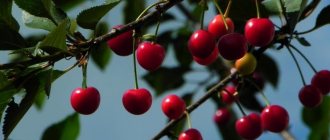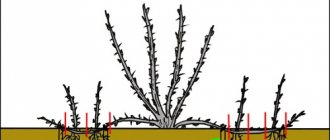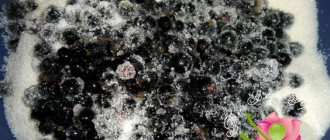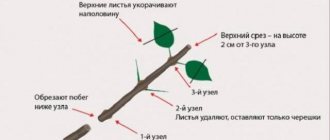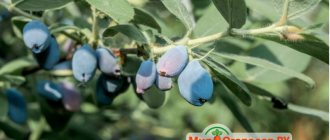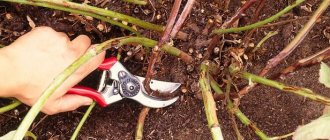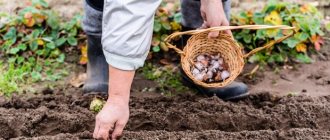Harvesting cuttings
In order for black currants to give a good harvest from cuttings in the fall, it is important to be able to harvest them correctly. For the propagation of currants, it is important to prepare the cuttings in advance. To obtain cuttings, you need to pick up a healthy bush that is 3-5 years old.
Harvesting time is selected depending on what type of currant:
- Black currant - in the warm autumn: late September and all October.
- Reproduction of red currants falls at the end of August and mid-September.
- White and golden reproduces by spring cuttings.
For the preparation of cuttings, autumn is considered the optimal time. This is due to the fact that at this time the plant loses less moisture and sap flow decreases. In spring, due to moisture, they are accepted faster and form a powerful root system.
Suitable shoots are cut off with a pruner, then, using a sharp knife, they are divided into seedlings, 20-30 cm each. The upper part of the workpiece is cut at an angle of 90 degrees, and the lower one - 60 degrees. The lower cut occurs at a distance of 0.5 cm from the kidney from above, and the upper cut - up to 1 cm from the lower kidney. For harvesting, it is not recommended to use the ends of the shoots, because they tend to dry out.
Then the places of the cuts are processed so that they do not lose their moisture. Hot paraffin wax or beeswax is used as this. Planting a cuttings of a plant is carried out in autumn days. When planting, the lower bud is covered with earth and it is from it that the roots sprout in the spring.
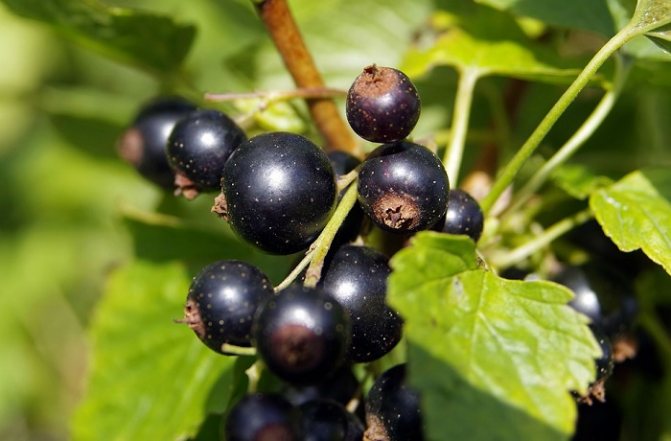
Pros and cons of propagation by cuttings
Cuttings of currants in the autumn are in great demand among gardeners. This has a number of advantages:
- one bush gives a lot of planting material;
- under comfortable conditions, the bush can be planted immediately;
- the seedling receives all the characteristics and positive qualities from the mother bush;
- the plant can be grown at any time of the year;
- this method updates the variety;
- no need to transplant seedlings, they take root perfectly in the planted place;
- almost all seedlings take root;
- the root system does not suffer.
However, the propagation of currants by cuttings also has its negative sides:
- the inability to predict the survival rate of the bush;
- danger of freezing due to severe frost.
In order not to remain completely without young seedlings in the spring, it is recommended to plant currant cuttings in large quantities in the fall.
Cutting currants in water
Spring cuttings of currants in water helps to speed up fruiting for a whole year.
Place 2 cut cuttings in each container (for example, a plastic cup will do). Water should cover no more than 2 buds. After 7-10 days, the first signs of roots will appear in the internodes.
After the formation of the root lobe, place each cutting in 1 container with a volume of at least 200-250 ml. After a while, leaves will appear. Flowering should not be allowed, so the flowers that appear must be cut off.
Glasses with seedlings should be in a bright place, but not in direct sunlight. Change the water in the containers from time to time. The whole process of spring cuttings lasts an average of 5-8 weeks. Plant prepared cuttings in early to late May, when the spring frost has passed.
Rules for harvesting cuttings
It is best to carry out the procedure after the summer heat has subsided, but the first frosts have not yet come. This is the period from the end of August to the first half of October.
Interesting!
When choosing a propagation period, it should be borne in mind that it takes another two weeks for the roots to germinate at the seedling.
In the spring, melted snow will have a good effect on the development of the root system, help them take root. Shoots should be at least 6 mm thick. You need to cut off the shoot from the root itself, so as not to leave hemp on the bushes. This negatively affects the further development of the shrub. All leaves are removed from the shoot.
When choosing a shoot, it is important to consider the shape of the bud. A healthy kidney should be oblong. If it is swollen and round, then it means that the kidney is infected with a tick.
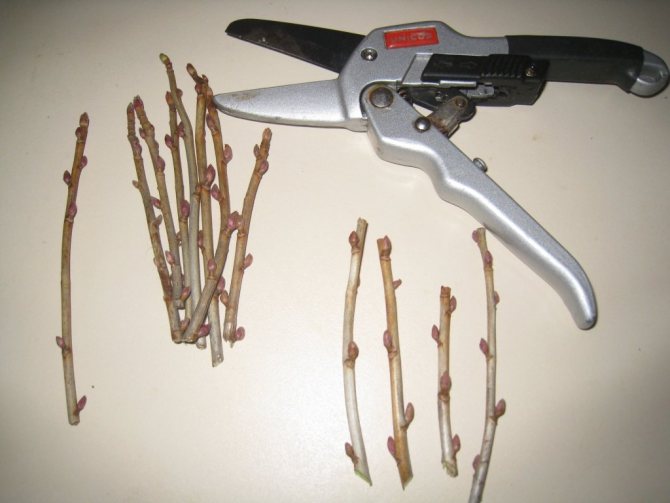

Soil selection
Before planting a certain variety of currants, it is important to consider what type of soil is on the site. Lightweight soil is suitable for white and red currants. Loamy soil is also suitable. For black berries, neutral soil is suitable.
Once the seedlings have been prepared by the gardener, you can start preparing the site for planting them. First of all, it must be leveled. Then clear the area of weeds that are firmly rooted there. These weeds interfere with the normal development of the planted seedlings.
After cleaning the site, you can start feeding the soil, and then digging it up. Compost or humus is used as a top dressing. You can also add phosphorus-potassium fertilizers.
If the gardener in the fall decided to plant the cuttings immediately in a permanent place, then the holes are dug in advance. This is done two weeks before disembarkation. When planting seedlings in spring, holes are also prepared in the fall.
How to propagate black currants by cuttings in the fall
Before propagating black currant by cuttings in the autumn, it is important to understand the peculiarities of its breeding. For example, planting density will depend on the degree of soil fertility. If the required amount of nutrients is not included in the composition of the soil, then it is better to make the distance between the bushes more so that they have enough all the important substances for the full growth of the plant.
It is also important to take into account the degree of illumination of the place, since the plant loves more sunlight. The shape of the future bush also plays an important role - if dense foliage is planned, then the distance should be made larger.
There are two ways to propagate currants in autumn:
- Green cuttings.
- Lignified cuttings.
Both methods have advantages and disadvantages, as well as breeding characteristics.
Green cuttings
The green stalk represents this year's shoot. As a rule, it is used when lignified shoots have not been prepared in advance. There is a certain sequence of planting such shoots.
First of all, a healthy mother bush is chosen, from which an shoot is made no more than 0.8 mm thick. The procedure is done in the morning, the shoot is divided into cuttings of 15-20 cm each.
Interesting!
Cuttings are planted at an angle of 45 degrees. If they are planted at right angles, then when the soil freezes, they will be forced out to the surface. And this will lead to the death of the plant.
Planting depth - 2-3 cm, the distance between future shrubs should be at least 20 cm.The soil must be well fertilized and loosened. The planted shoots are covered with a plastic bottle or glass jar. This will maintain the same moisture level, which will speed up the rooting process.
For two weeks, the cuttings are well watered. The soil should not dry out, as this will lead to the death of plants. After another two weeks, the processes are gradually opened for a short time, gradually increasing the duration. Once the scions are accustomed to the open air, the can can be removed completely.
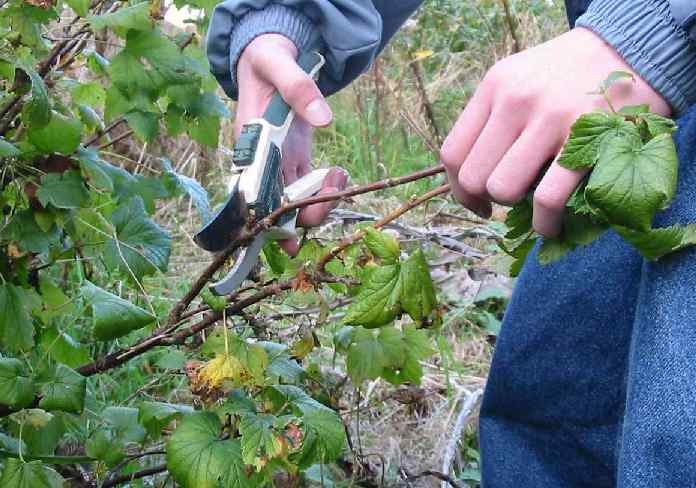

Lignified cuttings
The woody cuttings are the shoots of the last year. This is a more effective method, as it has a greater survival rate of shoots.
The planting depth of the cuttings should not exceed 15 cm, the distance between the shoots should be 12 cm. It is important to leave 2-3 buds on the surface in order to avoid the death of the plant. Only in this way will the shoot take root and germinate.
The mother bush must be healthy. The resulting cuttings are placed in a trench with compost and nutrients.
How to propagate red currants by cuttings in the fall
Reproduction by cuttings of red currants in autumn is possible when a warm winter passes in the region. In regions with cold winters, it is better to plant cuttings in a pot, and in the spring they are already planted in the ground.
There are two ways by which red currant propagation by cuttings is possible:
- Growth stimulating solution. The end of the shoot is placed for 7 days in such a solution, then planted in the ground. The room temperature should be at least +20 degrees.
- Peat and humus are mixed in a pot with earth and sand. The end of the shoot is placed in a pot so that the buds remain above the surface.
However, for those who do not want to plant red currants in the fall, there is an option to freeze the cuttings. The cuttings are placed in burlap, then wrapped in polyethylene and placed in a refrigerator for storage. During the winter, the blanks are periodically taken out and aired.
Method 1
In this case, you need to lower the end of the cutting (with the kidney) into a special stimulating solution. It can be prepared on the basis of "Kornevin", "Heteroauxin" or any other means.
In such a solution, the cuttings should be about 1 week. In this case, you need to ensure that the ambient temperature is not lower than +20 degrees. If it is too cold, the shoots will die and you no longer have to think about how to propagate red currants. In spring or autumn, there will simply be nothing to plant. You also need to ensure that mold does not appear on the cuttings.
After the "blanks" are saturated with the necessary nutrients, you can plant them in open ground or in a pot.
Rooting methods for currant cuttings
Before planting cuttings, they must first take root. This is necessary so that they quickly take root in open soil. There are three ways to root seedlings:
- in a special substrate;
- the use of growth stimulants;
- keeping the cuttings in water until they take root.
The last method is classic and is considered the most accessible and simple. Ready shoots should be placed in clean water for two weeks.
Interesting!
In order for the roots to germinate faster and without damage, the water in the container needs to be changed every day.
As a rule, the roots begin to appear after a week and a half, after another 4 days the cutting can be transferred to the ground.
The way of using the growth stimulant implies the addition of any special drug. Today there are a sufficient number of them on sale. With their help, the roots germinate faster and even more powerful is made.
The substrate is made using sod land and sawdust from alder or pine. Mix in a ratio of 1: 3. The cutting is placed in such a substrate. To prevent the seedling from dying, it is important to maintain high humidity both in the substrate and in the room itself where the sprouts are located.
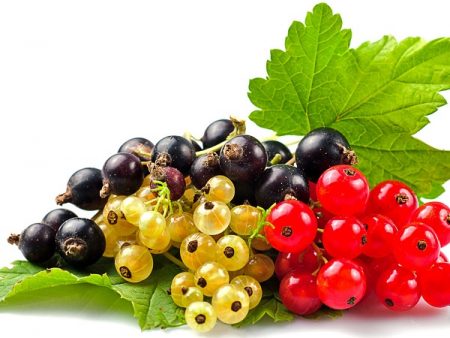

You may be interested in:
Currant care after fruiting Red, golden, black currant berries are so tasty and healthy, they look so beautiful in the garden, and so on ... Read more ...
Root formation stimulants
Popular remedies to speed up root formation include:
- Heteroauoxin is a powder mixture / tablets based on phytohormones. To prepare the nutrient solution, use 500 ml of soft water and 1 tablet (10 g).Half a liter of liquid mixture is enough to process 50 cuttings. The shelf life of the solution is 2 days, after which the amino acids are completely decomposed.
- Kornevin is a powder of indolylbutyric acid. Getting on a bare cut, it irritates its receptors and provokes the formation of callus. A high concentration of the drug is detrimental to plants, therefore it is often mixed with crushed activated carbon or ascorbic acid in equal proportions. The slices are dipped in dry Kornevin and, shaking off the excess, are planted in the ground.
- Epin is a broad-spectrum dry mix. It is used for growing rhizomes, protecting seedlings in winter, to increase their immunity. Red, golden and black currants are soaked in a 15% solution of "Epin" before planting in the open ground. This measure minimizes the risks of infection with viral infections and aphids.
- Ribav-extra is a concentrated preparation based on ginseng. It is enough to dilute 1 ml of liquid in 10 liters of cool water to treat the transplanted plants and heal damaged areas.
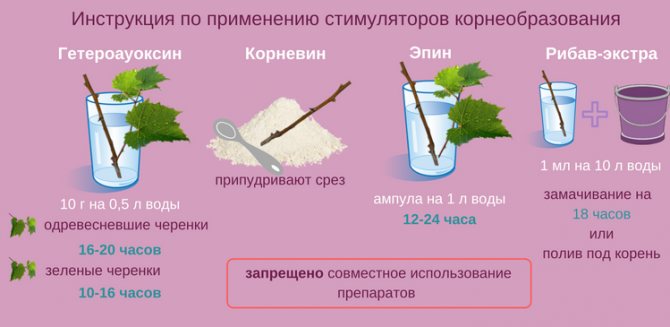

Memo
The optimal time for transplanting seedlings into open ground is 2-3 months after rooting. In this regard, some gardeners have the question of when to cut the planting material in order to be in time for the spring or autumn planting.
Planting cuttings in the ground
As soon as the seedlings appear, you can start planting them. The area where the seedlings will be planted should be sunny and protected from the wind. Despite the fact that currants love moisture, it is not worth overmoistening it. To avoid decay of the root system, it is important to find an area where groundwater will be deep. An ideal landing site would be an area on a slope.
Before planting seedlings, the site is fertilized. This requires organic matter, taking into account 1 square meter, 5 kg of substance is needed. In the ground, holes are made with a depth of at least 20 cm, the shape of the hole should be cubic, each side of which is 40 cm.
Before planting seedlings, it is important to carefully examine the root system. All roots that are dry or broken are cut off. In order to avoid root burns, before planting, a nutrient mixture is placed in the hole and filled with water per hole in 8 liters.
The seedling is placed in the hole at an angle, so that the root system deepens by 10 cm. As a result, several shoots are formed in the spring, which form the bush itself. A shoot of at least 20 cm should remain on the surface between the seedlings there should be at least 1 meter.
Preparing the soil for breeding
It is better to prepare the soil for planting currant cuttings in the fall. It is recommended to choose a sufficiently lit area. They must be protected from the wind and well damp.
Usually currants are planted along the borders of the plot, the distance between the bush and the fence should not be less than 1.2–1.5 m. Prepare the plot before planting seedlings. Dig the ground to a depth of 20-22 cm (on the bayonet of a shovel) and clear the weeds.
Currants prefer organic fertilizers, so put compost (or rotted manure) into the planting trenches. Thanks to this method of preparation, the earth will be able to accumulate enough moisture for better root formation. Organic fertilizers are applied at the rate of 3-4 kg per 1 m 2.
In the spring, before planting cuttings, you can make:
- granular superphosphate - 100-150 g / m 2;
- potassium sulfate or wood ash - 20-30 g / m 2.
It is advisable to check the acidity of the soil, at a pH of 4-5.5 it is necessary to add lime in an amount of 0.3-0.8 kg / m 2.
Currant care
Their further survival and further development depends on how to look after the seedlings after they are planted, and then in the spring. If not looked after well enough, the seedlings may die or produce poor harvests in the future.
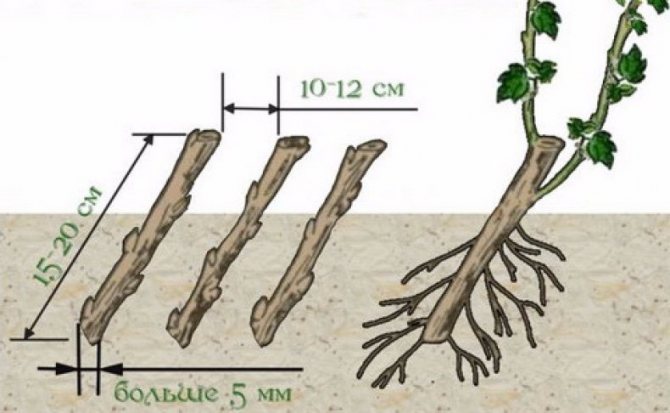

Immediately after disembarkation
Once the seedlings have been planted, they are well watered. It is important to constantly maintain high humidity so that the seedling does not die. After three weeks, the roots begin to take root, so the intensity of watering is significantly reduced. After that, they start feeding the plants.
It is important to mulch the shrubs with peat, straw or compost. It is placed on the surface in a layer of 10 cm. This will reduce the evaporation of moisture from the soil. Some gardeners use a film that covers the entire surface of the site, except for holes with seedlings.
In the spring, in order to speed up the process of awakening the bushes, all the shelters are removed and the plants are unmoved. After a year, the seedling turns into a full-fledged currant bush, which will delight with a bountiful harvest.
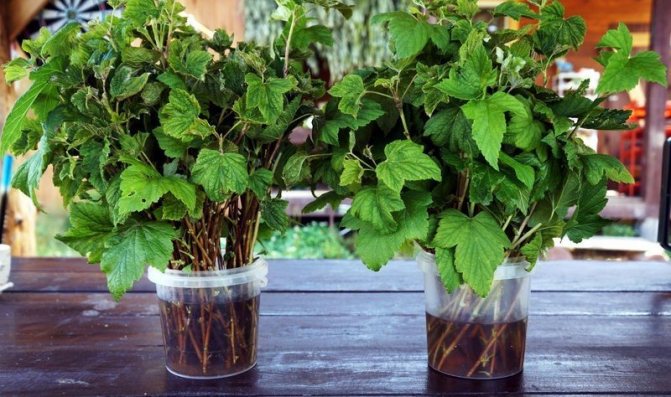

In the second year
In the second year after planting the seedlings, if necessary, they are transplanted to a permanent place. It is better to do this in the autumn, when the bush has already gained strength and energy.
The main care for a currant bush in the second year of life is feeding it and protecting it from pests. At home, to help the seedling gain strength and grow stronger for growth, special fertilizers will help. For this, superphosphate is quite suitable.
Of the pests, a kidney mite is a particular danger to currant bushes. This pest affects the kidneys themselves. Powdery mildew is also dangerous for the plant. Especially her subject to red currants.
Advantages and disadvantages
Autumn cuttings of currants have several advantages:
- it is possible to get an unlimited amount of planting material from one plant;
- young plants will be resistant to adverse environmental influences;
- the planting of a home-grown daughter bush is carried out at different periods - in spring, summer or autumn;
- breeding technology is much simpler than seed-assisted cultivation.
In autumn, sap flow is not so active, therefore, the seedlings have increased frost resistance and do not freeze over the winter. A slight loss of moisture contributes to the intensive growth of the root system in warm weather.
The only drawback of cuttings at this time of the year is unstable weather conditions, especially in areas of risky farming. Therefore, there is no 100% guarantee of the survival rate of such planting material.

